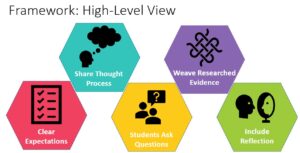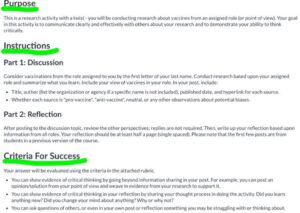Many faculty at UW Extended Campus use discussion strategies to engage their students and push them into higher levels of learning. From research, we know such strategies are necessary because most discussions do not naturally lead to higher levels of thinking (Darabi et al., 2011). Many instructors we have talked to have noticed this problem in their own courses—discussions can often feel like busywork or small talk. To achieve deeper discussions that show evidence of critical thinking and promote student engagement, research shows that your best bet is to provide the structure to make that happen (Brokensha & Greyling, 2015; Jarosewich et al., 2010). How do you create that structure? The Framework for Student Engagement and Critical Thinking can be used to provide the structure and support that will guide students into a deeper and more meaningful discussion and engage not only with the content but also with their peers. This five-component framework, developed out of research performed by Laurie Berry and Kristin Kowal (Berry & Kowal, 2022), can be used as a guide to help you add more dimension to your discussions.

Framework Component 1: Detailed Instructions and Clear Expectations
What is it?
Just like we can set up someone for success on a cross-country road trip with a good map, we can set up students for success with detailed instructions and clear expectations on how to approach the discussion. Research shows that when clear guidelines are in place, students can reach higher levels of learning (Gao et al., 2009). As instructional designers, we might see a discussion prompt where the instructions are clear enough so students will know what to do and where. However, the part worth pointing out is that the instructions and expectations can go further than one might think. For example, we can enhance a prompt that asks students to participate in the activity (post, reply, and how often) with information about why we are doing it (purpose statement) and specifics of how to be successful in the post. It’s not that most of the instructions are unclear to begin with, but that it’s useful to add a little more direction and detail to start off with since we’re in an asynchronous environment and have limited time. Back to the map metaphor, it’s the difference between a general map that would serve the purpose well for meandering or spontaneity, versus a map with identified tour stops pointed out for someone that has limited time or specific travel goals. The aim is to get students to show evidence that they are thinking more critically. Therefore, adding a purpose statement and criteria for success encourages students to push further and move beyond superficial discussion. An example of how you might include this is shown below.
Example
Below is what clear and detailed instructions might look like in a course:
Framework Component 2: Share Thought Process
What is it?
The next framework component invites students to share their thought processes in their posts. This is comparable to the think-aloud process, which you might already be using in your courses, or to showing your work, like when solving a math problem. Urging students to share their thought processes of how or why they might have arrived at the answer or conclusion can uncover more detail and depth, which, in turn, can create more opportunities for meaningful discussion. The following is an example of language you can include in your instructions: “Show evidence of critical thinking by sharing your thought process in doing the activity for all to see.” This framework component encourages students to share their thought process from the start.
Example
An effective way to illustrate this would be to apply it to subject domains. For example, students discussing a programming problem on the discussion board would not only provide solutions, but also why they proposed their answer; students working on a case study in a management course would be prompted to share not only their opinions or solutions but how they arrived there. We are asking students to make their thinking visible, not just their solutions.
Framework Component 3: Prompt Discussion with Questions
What is it?
The third framework component asks students to pose questions to invite more discussion with their peers. Asking students to probe deeper and include questions or share reflections in their posts can uncover areas that they may be struggling with or thinking about. Include language like the following in your instructions: “Ask questions of others in your post or reflect on something you may be struggling with or thinking about.”
By directing students to do this, you will invite others to easily join in the conversation and allow students to engage with both the content and each other. Using this technique, you may even notice the discussion includes elements of problem-solving and critical thinking, which are strong indicators of the students digging deeper into a topic. It can be rare to see students asking questions in their posts. However, when students post questions, it opens the door for others to easily join in the discussion.
Example
Students discussing optimal health and wellbeing might pose questions such as, “How can I best design a wellness program to ensure others will have the time and energy to use it?,” “How does technology impact an individual’s health and wellness?,” or, “Why does the environment play a role in one’s overall wellbeing?” Prompting students to pose questions to their peers not only invites conversation but enables the opportunity to share solutions.
Framework Component 4: Weave Evidence into Post
What is it?
You may have noticed this, but often when students are directed to use sources within a discussion, they merely post a link at the bottom of their post without referencing or citing it in the body of the discussion. This framework component instructs students to weave evidence or sources into the body of the discussion to allow you and others to quickly identify where or how they learned the information rather than assuming the information is tied to something they may have read. While you want to encourage students to form their own thoughts and opinions, you also want them to be able to support their thinking with evidence. To urge students to cite their source of information within their discussion itself, include language in your instructions such as: “Post an opinion or solution from your point of view and weave in your found evidence to support it.” or “Remember to reference the resources used to provide the evidence.”
Example
Students discussing individuals whom they think portray leadership or powerful influencer characteristics would state their personal claims while weaving in trusted sources to support and justify their thinking. An example post might be, “Oprah Winfrey comes to mind when I think of powerful influencers because according to Evans (2016), she exhibits the following characteristics…” While we are asking students to share their personal thoughts and opinions, we are also asking them to identify and support their reasoning.
Framework Component 5: Reflection
What is it?
It can be powerful to ask students to reflect on how they might have changed based on a learning experience. Adding a reflection component to your discussions can illuminate where construction of new knowledge has occurred. We recognize that including this component will take more time for students, but it is helpful for them to be able to synthesize not only their thoughts but also the thoughts and perspectives they gain from others. In a discussion post, you can include a reflection component with questions like these to uncover any kind of transformation that has happened during the activity: “Did you learn anything new? Did you change your mind about anything? How have you deepened or expanded your own thinking?”
Example
Students discussing their personal sense of purpose and developing a strategy to help them achieve their goals might include statements such as: “I never thought of it this way, maybe I need to go in a different direction or involve myself in a new community.” or, “I never thought of myself being in this particular role, perhaps this is something I need to consider if I do want to pursue this in more depth.” Encouraging students to reflect on the activity could lead them to creating new connections to both the content and to themselves.
Summary
The process of digging deeper and constructing new knowledge commands a level of attention from students that signifies their engagement. Whenever students can interact with content in ways that allow them to construct new meaning, they form a deeper connection to the content itself and are able to interact more meaningfully with others (Brokensha & Greyling, 2015; Galikyan & Admiraal, 2019; Jarosewich et al., 2010; Wang & Chen, 2008).
Download a PDF handout of the Framework for Student Engagement and Critical Thinking to use as a resource.
References
Berry, L. A., & Kowal, K. B. (2022). Effect of role-play in online discussions on student engagement and critical thinking. Online Learning, 26(3), 4-21.
Brokensha, S., & Greyling, W. (2015). Dispelling e-myths and pre-empting disappointment: Exploring incongruities between instructors’ intentions and reality in asynchronous online discussions. South African Journal of Higher Education, 29(4), 50–76.
Darabi, A., Arrastia, M. C., Nelson, D. W., Cornille, T., & Liang, X. (2011). Cognitive presence in asynchronous online learning: A comparison of four discussion strategies. Journal of Computer Assisted Learning, 27, 216–227.
Galikyan, I., & Admiraal, W. (2019). Students’ engagement in asynchronous online discussion: The relationship between cognitive presence, learner prominence, and academic performance. The Internet and Higher Education, 43, 1–9. https://doi.org/10.1016/j.iheduc.2019.100692
Gao, F., Wang, C. X., & Sun, Y. (2009). A new model of productive online discussion and its implications for research and instruction. Journal of Educational Technology Development and Exchange, 21(1), 65–78. https://doi.org/10.18785/jetde.0201.05
Jarosewich, T., Vargo, L., Salzman, J., Lenhart, L., Krosnick, L., Vance, K., & Roskos, K. (2010). Say what? The quality of discussion board postings in online professional development. New Horizons in Education, 58(3), 118–132.
Wang, Y.-m., & Chen, V. D.-T. (2008). Essential elements in designing online discussions to promote cognitive presence – A practical experience. Journal of Asynchronous Learning Networks, 12(3-4), 157–177.
